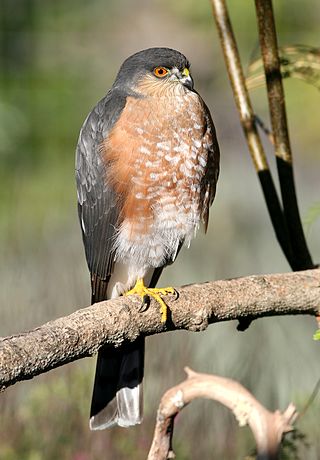
The sharp-shinned hawk or Northern sharp-shinned hawk, commonly known as a sharpie, is a small hawk, with males being the smallest hawks in the United States and Canada, but with the species averaging larger than some Neotropical species, such as the tiny hawk. The taxonomy is far from resolved, with some authorities considering the southern taxa to represent three separate species: white-breasted hawk, plain-breasted hawk, and rufous-thighed hawk. The American Ornithological Society keeps all four variations conspecific.

Short ribs are a cut of beef taken from the brisket, chuck, plate, or rib areas of beef cattle. They consist of a short portion of the rib bone and the surrounding meat, which varies in thickness. There are two major types of cuts: the "flanken", which is cut across the bone and leaves the bone just 1 to 2 inches or less in length, and the "English", which is cut parallel to the bone and leaves the bone up to 6 inches (15 cm) in length. English cut short ribs may be served individually, or three or four may be served connected to one another. Short ribs are popular in many international cuisines.

The rufous-tailed hawk is a species of bird of prey in the family Accipitridae.

The Hispaniolan parrot, also known as Hispaniolan amazon, is a species of psittaciform bird of the family Psittacidae endemic to Hispaniola, which includes the Dominican Republic and Haiti. Its white forehead, light beak, white eye-ring, blue ear patch, and maroon belly patch are the main features that differentiate it from other amazons. Its body measures about 28 centimeters in length. A typical adult weighs 250g (8.75 oz).
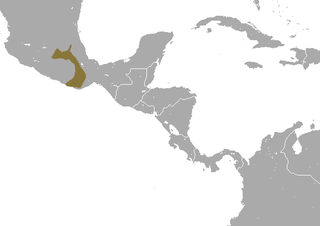
The chestnut-bellied shrew is a species of mammal in the family Soricidae. It is endemic to Mexico.
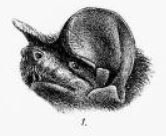
The African giant free-tailed bat, or African free-tailed bat is a species of bat in the family Molossidae. It is found in Democratic Republic of the Congo, Eritrea, Ethiopia, Kenya, Malawi, Mozambique, South Sudan, Tanzania, Zambia, Zimbabwe, and possibly South Africa. Its natural habitats are dry savanna and subtropical or tropical dry shrubland.

The eastern glass lizard is a species of legless lizard in the family Anguidae, endemic to the Southeastern United States. The streamlined, legless species is often confused with snakes. Glass lizards differ from snakes as they possess a moveable eyelid and an external ear opening, both of which are absent in snakes. Ventralis comes from the Latin "venter" meaning belly; this is in reference to the snake-like movement.
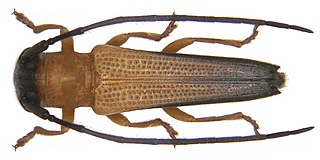
Nupserha is a genus of longhorn beetles of the subfamily Lamiinae, containing the following species:
Nupserha nigrolateralis is a species of beetle in the family Cerambycidae. It was described by Stephan von Breuning in 1955. It is known from Vietnam and Laos.
Nupserha vanrooni is a species of beetle in the family Cerambycidae. It was described by Per Olof Christopher Aurivillius in 1916. It is known from Tanzania and Malawi.
Nupserha malabarensis is a species of beetle in the family Cerambycidae. It was described by Maurice Pic in 1939.
Nupserha annulata is a species of beetle in the family Cerambycidae. It was described by James Thomson in 1857. The species is reported from Bhutan, India, Nepal and Pakistan.
Nupserha apicata is a species of beetle in the family Cerambycidae. It was described by Léon Fairmaire in 1891.
Nupserha bicolor is a species of beetle in the family Cerambycidae. It was described by James Thomson in 1857.
Nupserha bidentata is a species of beetle in the family Cerambycidae. It was described by Johan Christian Fabricius in 1792, originally under the genus Saperda.

Nupserha fricator is a species of beetle in the family Cerambycidae. It was described by Dalman in 1817. It is known from Java, Sulawesi, India, Myanmar, Philippines, Sumatra, Malaysia, and Thailand.
Nupserha homeyeri is a species of beetle in the family Cerambycidae. It was described by Harold in 1879.
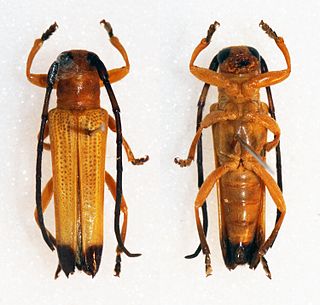
Nupserha ustulata is a species of beetle in the family Cerambycidae. It was described by Wilhelm Ferdinand Erichson in 1834. It is known from the Philippines and Malaysia.

Nupserha vitticollis is a species of beetle in the family Cerambycidae. It was described by Hermann Julius Kolbe in 1893. It is known from Tanzania, the Democratic Republic of the Congo, Cameroon, Uganda, and Togo.









